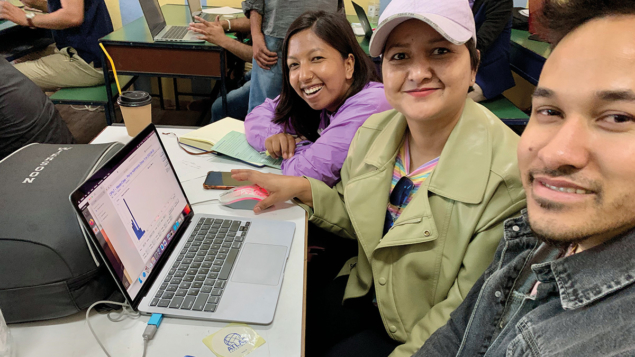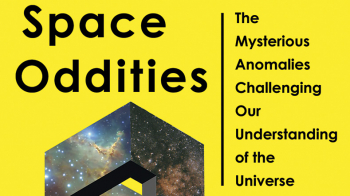Outreach is as essential as hardware, computing and analysis, says co-chair of the International Particle Physics Outreach Group, Steve Goldfarb. Without it, we won’t have the support we need to build future facilities.

This year, the International Particle Physics Outreach Group (IPPOG) celebrates its 25th anniversary. Our group is an international collaboration of active particle physicists, communication experts and educators dedicated to disseminating the goals and accomplishments of fundamental scientific research to the public. Our audiences range from young schoolchildren to college graduates and teachers, from the visiting public to heads of state, and we engage them in classrooms, laboratories, experimental halls, music festivals, art exhibitions, office buildings and government offices across the planet. The activities we use to reach these diverse audiences include public lectures, visits, games, exhibits, books, online apps, and pretty much anything that can be used to demonstrate scientific methodology and instil appreciation for fundamental research.
What drives us to commit so much effort to outreach and public engagement when we are already deeply invested in a field that is both time and labour intensive? First of all, we love doing it. Particle physics is an active and exciting field that lies at the forefront of human understanding of the universe. The analysis methods and tools we employ are innovative, our machines and detectors are jaw-dropping in their size and complexity, and our international collaborations are the largest, most diverse ever assembled. It is a privilege to be part of this community and we love sharing that with those around us.
Secondly, we’ve learned that public engagement improves us as scientists. Learning how to distil complex scientific concepts into understandable descriptions, captivating stories and relatable analogies helps us to better comprehend the topics ourselves. It gives us a clearer picture in our own minds of where our work fits into the larger frame of society. It also significantly improves our communication skills, yielding capabilities that help us down the road as we apply for grants and propose new projects or analyses.
Thirdly, we also understand our moral obligation to share the results of our research with society. The endeavour to improve our understanding of the world around us is rooted in millennia of human evolution and culture. It is how we not only improve our own lives, but also how we provide the tools future generations need to survive. In more practical terms, we realise the importance of engaging those who support our research. That includes funding bodies, as well as the voters who select those bodies and prioritise the deployment of resources.
Finally, but equally as important, we realise the value to both our own field and society at large of encouraging our youth to pursue careers in science and technology. The next generation of experiments will include machines, detectors and collaborations that are even larger than the ones we have today. Given their projected lifetimes, the grandchildren of today’s students will be among those analysing the data. And we need to train that workforce today.
Birth and evolution
Dedicating time and resources to outreach efforts is not easy. As researchers, our days (and often nights) are taken up by analysis meetings, detector shifts, conference deadlines and institutional obligations. So, when we do make the effort it needs to be done in an effective manner, reaching as large and diverse an audience as possible, with messages that are clear and coherent.
Former CERN Director-General Chris Llewellyn Smith certainly had this in mind when he first proposed the establishment of the European particle physics outreach group (EPOG) in 1997. The group held its first meeting on 19 September that year, under the chairmanship of Frank Close. Its primary objectives were to exchange ideas and best practices in particle-physics education and outreach, to define common goals and activities, and to develop and share materials supporting the efforts.

The original members of EPOG were delegates from the CERN Member States, one each from the four major LHC experiments, one each from the CERN and DESY laboratories, and a chair and deputy chair assigned by the European Committee for Future Accelerators (ECFA) and the high-energy physics branch of the European Physical Society. Over the course of the following 25 years, EPOG has expanded beyond Europe (becoming IPPOG), developed major worldwide programmes, including International Masterclasses in Particle Physics and Global Cosmics, and established itself as an international collaboration, defined and supported by a memorandum of understanding (MoU).
Today, the IPPOG collaboration comprises 39 members (32 countries, six experiments and one international lab) and two associate members (national labs). Each member, by signing the MoU, commits to supporting particle-physics outreach worldwide. Members also provide modest funding, which is used to support IPPOG’s core team, its administration and communication platforms, thus facilitating the development and expansion of its global programmes and activities.
The Masterclasses programme now reaches tens of thousands of students in countries spread around the globe, and is engaging new students and training new physics mentors every year. The Global Cosmics portal, hosted on the IPPOG website, provides access to a wide variety of projects distributing cosmic-ray detectors and/or data into remote classrooms that would not normally have access to particle-physics research. And a modest project budget has helped the IPPOG collaboration to establish a presence at science, music and art festivals around the globe by supporting the efforts of local researchers.
Most recently, IPPOG launched a new website, featuring information about the collaboration, its programmes and activities, and giving access to a growing database of educational resources. The resource database serves teachers and students, as well as our own community, and includes searchable, high-quality materials, project descriptions and references to related resources procured and contributed by our colleagues.
Our projects and activities are reviewed and refined periodically during twice-annual collaboration meetings hosted by member countries and laboratories. They feature hands-on activities and presentations by working groups, members, partners and panels of world-renowned topical experts. We present and publish the progress of our activities each year during major physics and science-education conferences. Presentations are made in parallel and poster sessions, and plenary talks, to share developments with the greater community and offer opportunities for their own contributions.
The challenging road ahead
While these accomplishments are noteworthy and lay a strong basis for the development of particle-physics outreach, they are not enough to face the challenges of tomorrow. Or even today. The world has changed dramatically since the days we first advocated for the construction of our current accelerators and detectors. And we are partly to blame. The invention of the web at CERN more than 30 years ago greatly facilitated access to and propagation of scientific facts and publications. Unfortunately, it also became a tool for the development and even faster dissemination of lies and conspiracy theories.
Effective science education is crucial to stem the tide of disinformation. A student in a Masterclass, for example, learns quickly that truth is found in data: only by selecting events and plotting measurements is she/he able to discover what nature has in store. And it might not agree with her/his original hypothesis. It is what it is. This simple lesson teaches students how to extract signal from background, truth from fiction. Other important lessons include the value of international collaboration, the symmetries and beauty of nature and the applications of our technology to society.
How do we, as scientists, make such opportunities available to a broader audience? First and foremost, we need more of us doing outreach. Many physicists do not make the effort because they perceive it as costly to their career. Taking time away from analysis and publication can be detrimental to our advancement, especially for students and junior faculty, unless there is sufficient support and recognition. Our community needs to recognise that outreach has become a key component of scientific research. It is as essential as hardware, computing and analysis. Without it, we won’t have the support we need to build future facilities. That means senior faculty must value experience in outreach on a par with other qualities when selecting new hires, and their institutions need to support outreach activities.
We also need to increase the diversity of our audience. While particle physics can boast of its international reach, our membership is still quite limited in social, economic and cultural scope. We are sorely missing women, people of diverse ethnicities and minorities. Communication strategies and educational methods can be adopted to address this, but they require resources and dedicated personnel.
That’s what IPPOG is striving for. Our expertise and capabilities increase with membership, which is continually on the rise. This past year we have been in discussion with Mexico, Nepal, Canada and the Baltic States, and more are planned for the near future. Some will sign up, others may need more time, but all are committed to maintaining and improving their investment in science education and public engagement. We invite Courier readers to join us in committing to build a brighter future for our field and our world.








